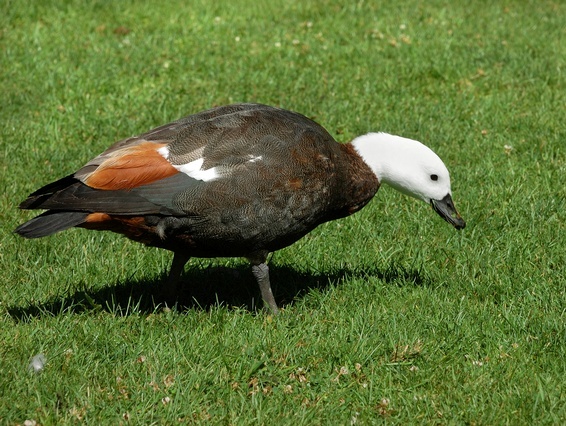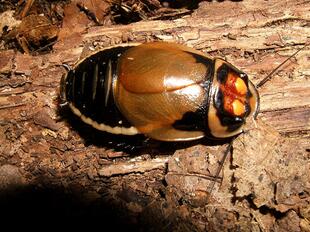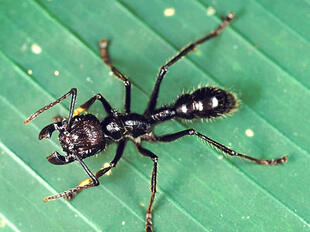
Paradise shelduck(Tadorna variegata)
Phylum —chordata
Class — aves
Order — anseriformes
Family — anatidae
Genus –tadorna
Appearance
Paradise shelducks are a colorful, large bodied species of duck that differ in features depending on the sex. Both females and males have chestnut-color undertails, primarily black wing feathers with green secondary wing feathers, and upper wing surface weathers that are white. They have black legs and webbed feet for swimming. Paradise shelducks average 65 cm in length and weigh between 1.5 and 2 kg.
The adult male paradise shelduck has blue-black head and neck, with a black, rump, and tail; back and flank are lightly flecked with a pale yellow color. The wing of males has contrasting white upper-coverts and black remiges, metallic green speculum feathers, and rusty brown tertials feathers. The males also have a dark grey flecked with pale-yellow breast and abdomen, chestnut undertail and underwing, and black iris, bill, legs, and feet.
The female paradise shelduck, unlike the male, has an entirely white hand head and neck with a dark grey back heavily flecked with pale yellow. The rest is very similar to the male with the female's body being dark or light chestnut depending on age and stage of molting.
Habitat
Paradise shelduck are the most widely distributed waterfowl in New Zealand.
Behavior
The molting season lasts from December – February.During the molting season, distinct flocks will gather at traditional sites, the one- and two-year-old birds arrive first, followed by the failed breeders, and then by the successful breeders arriving late January. At molting sites, the birds gather in open water with high open hillsides surrounding them acting as vantage points, many sites also have dense vegetation for refuge. Early departures from molting sites begin in March – April where adults will return to their distinct breeding territories.
Diet
The paradise shelduck is a diurnal omnivore. The adults are primarily herbivorous preferring pasture grasses and clover while the young eat mostly aquatic insects for the first five weeks of life before grazing on land.
Reproduction
They first breed in their second and third years forming long-term pair bonds, often lasting for life, and defend their territories. If one of the individuals of the couple dies, the other will keep the same territory and will find another mate.
The egg-laying season begins early August and peaks by the end of the month, egg-laying occasionally extends into October but rarely into November.
The paradise shelduck can nest in a variety of places including, inside hollow logs, under fallen logs, in-ground holes or trees up to 20 m high, rabbit burrows, under haystacks, piles of fence posts, tussocks, in rock crevices, under buildings, among tree roots, or in culverts.
Clutches usually range from 5–15 eggs, with most clutches numbering over 12 being a collective nest from two females.The incubation period lasts for 30–35 days with only the female looking after the nest 21–22 hours a day only leaving at dawn and dusk for 1 hour, male only stands next to the nest after eggs have hatched.
The fledging period for the downy young lasts on average eight weeks, parenting is shared during this time with the young feeding independently and being kept close to the nest typically around 500 m.
Incaptivity
Lifespan -up to 20 years.
Shelducks are perfectly adapting to life in aviaries, grow well and regularly give healthy offspring, which are selflessly taken care of by both parents. The main difficulty faced by beginners in breeding of these birds is their excessive aggressiveness during the breeding season, intolerance of the presence of birds of any kind in the breeding territory. A male guarding a clutch of a female or brood can pounce on both a large bird of prey and a predatory mammal and a human.
At the same time, a couple with their own brood often takes other birds` chicks under their protection, and sometimes even takes them away from their parents. Young birds under 2 years of age who have not reached sexual maturity are more tolerant to life in a large flock. Adult birds get along peacefully with other representatives of waterfowl during the molting period at the end of the nesting period. But, in addition to seasonally aggressiveness when the male defending its territory can kill smaller ducks and even geese, we need to understand that bird keeping in mixed flocks can be the reason for hybridization with any of the members of the genus Tadorna, as well as geese, breasted geese and domestic ducks.
Large aviaries as a place for seasonal keeping of a small group of adult immature or molting birds should be much more spacious than for any other waterfowl. The minimum size of the enclosure for a pair of shelduckscannot be less than 100 square meters. For good growth, regular reproduction and preservation of the brood population, it is necessary to provide the shelducks with the opportunity to graze on a large area with low grass. It is recommended to equip a large, shallow pond.
During a long frosty period, ducks need dry, enclosed spaces. The room temperature should be at least 10 oC.If birds are outsideduring the cold weather for a long period of time they have frostbite of the paws.
In captivity, it is important for shelducks to have a possibility of grazing on grass. The natural herbal diet is supplemented with special compound feeds and bread. In winter, the grain diet consists of wheat, oats, lentils, peas, crushed corn is supplemented with finely chopped peelings of vegetables such as potatoes, carrots, cabbage and others.
Hatched ducklings are fed with industrial starter feed. Duckweed, a lot of chopped greens − lettuce and spinach, insects and earthworms are useful for the growth of chicks. Providing access to low-grass pasture from an early age guarantees the brood rapid growth and maximum survival. A shallow container with clean drinking water, which is replaced as it becomes contaminated, but at least once or twice a day, should always be in the place of feeding the bird.
 Russian
Russian
 English
English
























